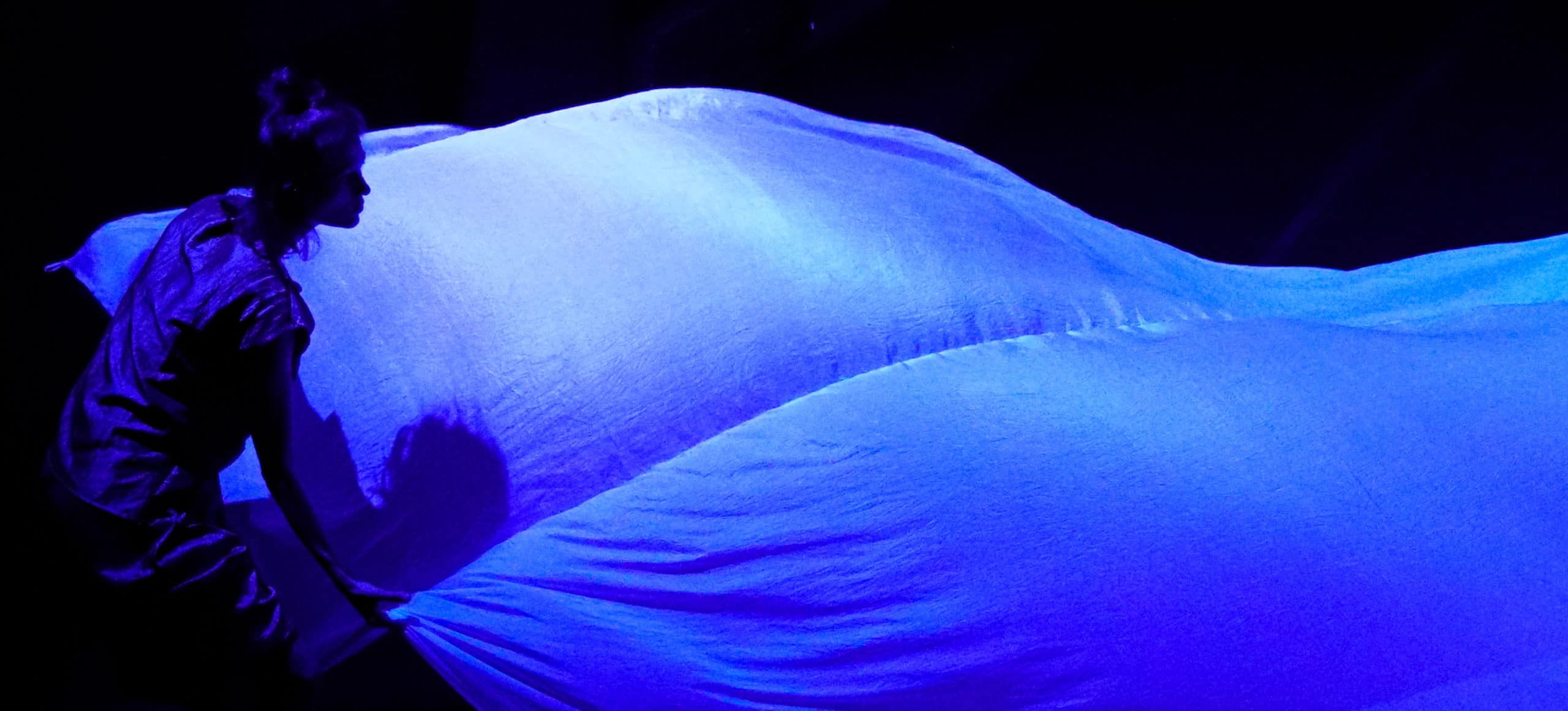
THE ETERNAL DRAGONFLY
MAY ZARHY: LIBELLE
Our everyday life today is not the same as it was 14 months ago. This was felt acutely by the team around May Zarhy, whose play Libelle was postponed by one year. Nico Grüninger, who in his role as mentor visited the play before and after the long break, describes his impressions and, in the end, experiences his very own moment of eternity.
By Nico Grüninger | 29th May 2021
Munich, end of February 2020: The first rehearsal phase of Libelle is nearing its end. After several weeks of experimenting and collecting material, the team around May Zarhy is facing a last break before the final rehearsals. At this point, normality – as we knew it then – still prevails: People are squeezing into packed streetcars, hugging and kissing friends, acquaintances, and strangers, sitting close together in theaters and dancing in crowded, stuffy clubs. But for a few days now, terms have crept into the conversation that worry us, even if we don’t want to take them too seriously yet: exponential growth, hand hygiene, spacing, capacity constraints, border closures… A few days later, everything goes quiet. There’s no more talk of final rehearsals or performances. People start to wonder whether this crisis could last several months. Nobody thinks of years yet.
A year passes
Now, in May 2021, more than 14 months or half an eternity later, Munich is still a long way from what used to be taken for granted. But the premiere of Libelle will now definitely take place – and with a small audience, no less! The path that led to this point was long and complicated for the entire team. Multiple postponements required constantly changing plans and coordinating with other projects, which led to personnel changes within the crew. With regard to content, too, changes were unavoidable. Originally, singing was meant to play an important role on stage, including the children in the audience. For obvious reasons, May Zarhy had to part ways with this idea and develop a new musical concept together with musician Lena Geue. The team stayed in touch virtually last year; there were also some attempts to continue rehearsals via Zoom. Although May considers these experiences valuable, she realized once and for all that when it comes to dance, she really needs real bodies in real spaces. After the first strict lockdown, staying in her hometown of Tel Aviv, she was able to return to the studio with small groups and, due to the improved public health situation there, was even able to do a solo performance in front of an audience. In the meantime, the other team members (Elpida Orfanidou, Susanne Grau (performance), Federico Protto (set design), Dennis Dieter Kopp (lighting design)) also gained experience in handling the changed circumstances in a variety of other projects. The reunion felt like a reward, she says. Thanks to daily tests, the rehearsal stage seems like island of sorts, where the physical closeness that is so central to the creation process is finally again possible. May says that it’s immensely satisfying to once more be able to pursue the work that fulfills her. She speaks of a privilege that should never be taken for granted.
The story of this production is one that has played out thousands of times in recent months, across the globe. And yet it is unique and worth telling.
Beings in glistening light
A week before the premiere, the rehearsal studio on Auenstraße is bustling with activity. A test audience of seven children has been won over for a rehearsal run. Seven children – how wonderful! After all, how can a play for young audiences succeed without their involvement in the rehearsal process? The rules are still strict: All children wear masks, keep their distance, the accompanying adults are additionally tested, and there is regular airing. But after everyone is seated and it gets quiet in the audience, none of the restrictions and guidelines matter anymore. A rhythmic tapping starts. Two beings enter the landscape on stage, which is bathed in glistening light. Their movements are the same and yet different, alternating between fast and slow, between soft and robot-like. Do the two know each other? Are they perhaps even one and the same? Or are they now just meeting for the first time? New sounds and melodies begin. Does the music create the movements or do the movements create the music? Do the different materials create the sounds or does everything depend on the light? The two beings – or are there suddenly more than two? – also begin to make sounds. They disappear, reappear. The environment changes – and the beings themselves undergo various transformations as well. Did we suddenly land on a catwalk? Wind begins to blow. A large swath of white fog rolls in – or is it water, a glacier tongue, a giant dress? Everything shimmers and glitters, swirls, rushes, and billows – and then, suddenly, it’s all over. Two performers stand on the rehearsal stage and take a bow.
What are 14 months anyway?
Did all this really just happen or did I imagine it? Were my eyes open or closed? Did the other audience members see the same things as I did? I don’t know – but then again, I don’t need to know.
One thing, however, is clear: In this world, the virus plays no role. The dragonfly (german: Libelle), which gives the play its name, seems never to have been interested in it anyway. It was already around when dinosaurs still walked the earth. The little animal is said to be 325 million years old. 325 million years. This allows a hint of eternity to emerge. What are 14 months compared to that!















